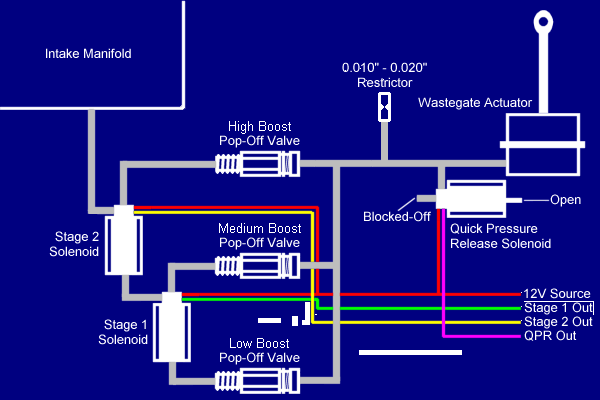Wastegate Control Valve Quick Pressure Release
Description
This page describes a method to eliminate the problem of turbo spool-up
between shifts when using wastegate control valves (WCVs). To read
more about WCVs, see the Increasing Boost With Wastegate
Control Valves page. In order to prevent spikes when using WCVs,
the pressure relief bleed that is required to close the wastegate has to
be kept small. However when this bleed gets too small, it causes
the wastegate to stay open. So during fast shifts, you will not get
good spool-up between shifts because the wastegate is still lingering open.
This is especially apparent with smaller turbos (which are also more prone
to boost peaking). The way this system works is to eliminate this
delay by installing a solenoid controlled by a pressure switch or an Electronic
Engine Performance Controller (EEPC) to relieve the pressure in the
wastegate actuator quickly. A small restrictor is still required
so that the pop-off valve can still regulate the pressure. Without
the restrictor, the valve will just "pump-up" the actuator and the result
will be less boost than desired.
Using A Pressure Switch
Using a pressure switch for this is quite simple. Install a solenoid
near the location that the bleed is located. You can install another
"T" fitting, or use a "cross" fitting for the bleed and solenoid.
Connect the hose from the new fitting to the center barb on the solenoid.
One of the remaining two barbs will need to be blocked off. Which
one depends on how you wire the pressure switch. I will assume that
the switch and solenoid will be wired so that when the solenoid is on,
the bleed is closed. In this case, the normally open barb on the
solenoid will have to be blocked off. For more information on solenoids,
see the
Understanding Solenoids page.
Your configuration will then be something like this:

To calibrate this setup, you need to set the pressure switch so that
it turns on at a few psi below your boost setting. So, if you set
your pop-off valve to about 14psi, then you want to set the pressure switch
to around 10-12psi. Setting the pressure switch pressure too close
to the desired boost may not give the pop-off valve enough time to open
the wastegate. The result would be boost peaking. You can also
just set the pressure switch to 0 psi, so that the pressure release will
only take place when the engine is in vacuum.
Using The EEPC
The configuration for adding the quick pressure release feature with an
EEPC is basically the same. The only difference is that the solenoid
is activated by the circuit instead of pressure switch. I trust that
you can envision this minor change. Since the EEPC is generally used
for multi-stage WCVs, I have provided a diagram for a 3-stage WCV with
quick pressure release. As with most EEPC setups, the EEPC circuit
provides the ground to the solenoids, so each solenoid needs a common 12V
source. It's always a good idea to put a small fuse on this line,
close to the power source. About 1A should work.

The calibration procedure for this setup is the same as the pressure
switch. You want to adjust the EEPC output for the quick pressure
release (purple wire) to a few psi below the low boost setting.
Again, you could also just set it to 0 psi (about 2.5V on a 2 bar MAP sensor)
and not worry about it. For more information about install the EEPC,
see the Multi-Stage Wastegate Control Valve
Using The EEPC page.
This page is maintained by Russell W. Knize and was last updated 04/19/99.
Comments? Questions? Email
minimopar@myrealbox.com.
Copyright © 1996-2003 Russ W. Knize


